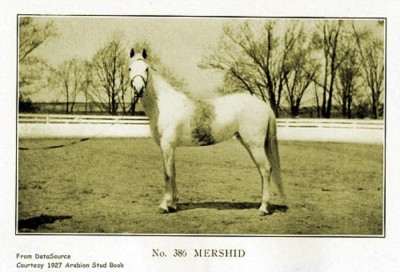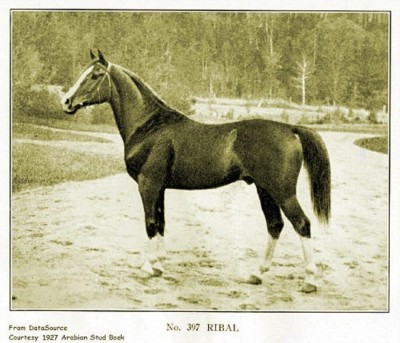Bedouins did not like horses with dished profiles*
Arabian horses do not come in one type or form; rather they are of many, many types; unfortunately, in this day and age, one type has come to dominate and has spead everywhere; it is the type associated with the dished profile, so popular in show contests.
According to a number of oral stories from old Bedouin men, dished or concave profiles were considered a physical defect, and horses with such profiles were not sought after. It was considered that such horses could not keep up with other war horses, because the slope or angle of the “dish” would somehow affect the horse’s capacity to exhale large quantities of air while running.
The two photos below show two separate types of heads largely found among Bedouin horses of yesterday and today. The first one is a picture of Mershid (Hamrah x Dahurah), a Kuhaylat al-Ajuz mare in the USA. Mershid’s head is very reminiscent of desert breds in Saudi Arabia today. The second one represents the stallion Ribal (Berk x Rijma), who looks like another type of Bedouin horses to be found in Arabia.


*Written by Pure Man and Translated by Edouard
How true this is. It seems that many newcomers to this breed have never seen how beautiful an Arabian can be without the dished face. Nearly 40 years ago I saw many of them that were that way. Even our first Al Khamsa mare, Sirbana, born 1959, did not have a dished face at all, yet with her large eyes, broad forehead, balanced head proportions and graceful mitbah many who saw her thought she was beautiful. She was infact quite like the Davenport mare Portia who was another lovely example of a beautiful 100% Bedouin type head. When you see these types in person you realize much more beauty than could have been captured in those old photos.
Examining photos of the Al-Khamsa ancestors and other desert bred horses, I seldom see a dished profile face.
So from where the pronounced dished face originated?
Hi, Bassam,
I think there were some dished face horses: *Haleb and *Abeyah in the Davenport importation had rather pronounced dishes. I think some people selected for that, and kept going for more and more extreme profiles as time passed, sometimes ignoring other conformational faults. It has reached a point today where some horses have no width between or above the eyes, no width between the jaws, and such fragile jaws that their teeth are tiny and fall out. What a shame!
We love beautiful heads as much as anyone, but the forehead, above the eyes and where the cranium is, should be both long and wide, and the skull itself should not be small, but large, especially in the width between the jaws, and allowance made for wide nostrils and sound teeth.
The Blunts’ mare Sherifa was another with a dished profile. Davenport and the Blunts made a point of mentioning how much the heads of Sherifa and *Abeyah were admired by the Bedouin.
April 2, 1878: “[Sherifa] has the finest head I ever saw.”
April 4, 1878: “Jedaan [ibn Mhayd] began asking about my Mecca mare [Sherifa] — ‘What is that mare?’ — and he evidently took a fancy to her.”
It might be safe to say that not all old Bedouin horsemen liked the same kind of horse, any more than all old American horsemen like the same kind of horse.
The heads of several of my own horses tend toward straighter profiles, although certain of them have more dish. None of them approach Sherifa or *Abeyah. I don’t worry about whether the heads are dished or not. I enjoy the variety. More important to me is the placement of a kind eye, size and shape of nostrils, width between the jaws, width between the eyes, dryness, and how well the head sets up in a bridle. I don’t like a tiny, pony head on an Arabian. I feel fortunate to have grown up knowing horses like Sir, Portia, Prince Hal, June, Ibn Alamein, Moth, Dharanad, Lady Fair, Bint Antan, and yes Culpurnia too, because they helped calibrate my “eye” for a horse.
There is certainly something to what Pure Man says, of course. I’ve heard of a breeder of Arabians in the U.S. who has selected for the very extreme heads, and she openly complains that her horses, I’m told by a friend of hers, do have trouble with their breathing under certain conditions. Now, I understand that an individual horse might develop heaves or other problems, but if a whole herd of Arabian horses has trouble breathing, of all things, that program has really run off the rails.
One final disclaimer — I’ve never actually seen the horses described above or met their breeder, so it’s just hearsay that I’m passing along, for whatever it might be worth.
Maybe I have some Bedouin blood in me because I have always found the extremely dished face to be repugnant. That goes as well for the exaggerated, long, snaky neck. These profiles of “typey” horses make me think of sea horses. It was only when I discovered the Davenports that I fell in love with Arabians. Nourished by photos and information supplied online by Charles and Jeanne I learned about real Arabian horses and finally owned one (though she was not straight Davenport Charles told me). Her name was Julia and she was bred by James Bullard, a friend of Charles’. She was everything a Bedouin horse was claimed to be. Could I have kept her in my bedroom I would have. Instead I often reclined with her for a nap in her stall when she chose to enter it. My husband declared me insane. Little did he know.
It occurred to me (too late of course) that “repugnant” is too strong a word. It came to me in that moment because I often find the hand of man to be intrusive in the extreme. In seeking to create something of alleged greater beauty, he goes too far, creating instead a caricature. With any breed, be it horse or dog, the balance can be tipped, resulting, in the worst case scenario, physical disabilities that cause suffering to creatures who have no choice in the bargain.
I hope I did not offend anyone as certainly it was not my intention.
I agree with Elena Latici.
My late stallion didn’t have a dished face. He was perfect.
I am sure he was. Overly dished faces are ridiculous.